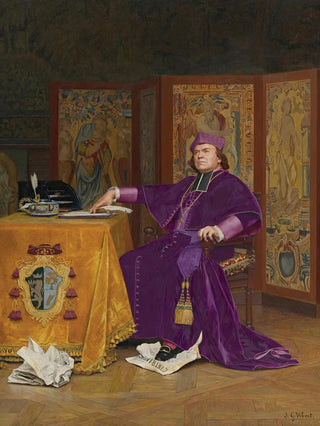Art print | The Bishop's Wrath - Jehan Georges Vibert


View from behind

Frame (optional)
Art print La Colère de l'évêque - Jehan Georges Vibert – Engaging introduction
The canvas "La Colère de l'évêque" by Jehan Georges Vibert is a work that immerses the viewer in a universe that is both humorous and revealing of the customs of 19th-century society. In this vibrant scene, the bishop, an emblematic figure of religious authority, is depicted in a moment of anger in response to an unexpected situation. The richness of details and the liveliness of expressions capture an emotion that transcends the simple frame of painting. Vibert, with his keen sense of observation, manages to create an atmosphere where the sacred and the profane meet, offering a reflection on human nature and its flaws.
Style and uniqueness of the work
Vibert's style is characterized by an exceptional mastery of color and meticulous attention to detail. In "La Colère de l'évêque," the shades of colors blend harmoniously, creating a dynamic atmosphere that immediately draws the eye. The faces of the characters, painted with remarkable precision, express a range of emotions from surprise to indignation. This ability to capture moments of life, often imbued with humor, is one of the artist's signatures. The composition is carefully orchestrated, with each element having its place to strengthen the visual narration. The work stands out for its balance between the seriousness of the subject and the lightness of its treatment, making this canvas a true masterpiece of narrative painting.
The artist and his influence
Jehan Georges Vibert, born in 1840, was a French painter whose work is part of the lineage of great masters of the 19th century. Influenced by academic traditions while opening up to new artistic trends, Vibert developed a unique style that is his own. His career, marked by an exploration of religious themes and genre scenes, reflects a deep understanding of the social dynamics of his time. The artist was also a keen observer of daily life, which is reflected in his works imbued with a certain irony. His ability to combine realism with a touch of fantasy influenced many contemporary and later artists, thereby contributing to enriching the

Matte finish

View from behind

Frame (optional)
Art print La Colère de l'évêque - Jehan Georges Vibert – Engaging introduction
The canvas "La Colère de l'évêque" by Jehan Georges Vibert is a work that immerses the viewer in a universe that is both humorous and revealing of the customs of 19th-century society. In this vibrant scene, the bishop, an emblematic figure of religious authority, is depicted in a moment of anger in response to an unexpected situation. The richness of details and the liveliness of expressions capture an emotion that transcends the simple frame of painting. Vibert, with his keen sense of observation, manages to create an atmosphere where the sacred and the profane meet, offering a reflection on human nature and its flaws.
Style and uniqueness of the work
Vibert's style is characterized by an exceptional mastery of color and meticulous attention to detail. In "La Colère de l'évêque," the shades of colors blend harmoniously, creating a dynamic atmosphere that immediately draws the eye. The faces of the characters, painted with remarkable precision, express a range of emotions from surprise to indignation. This ability to capture moments of life, often imbued with humor, is one of the artist's signatures. The composition is carefully orchestrated, with each element having its place to strengthen the visual narration. The work stands out for its balance between the seriousness of the subject and the lightness of its treatment, making this canvas a true masterpiece of narrative painting.
The artist and his influence
Jehan Georges Vibert, born in 1840, was a French painter whose work is part of the lineage of great masters of the 19th century. Influenced by academic traditions while opening up to new artistic trends, Vibert developed a unique style that is his own. His career, marked by an exploration of religious themes and genre scenes, reflects a deep understanding of the social dynamics of his time. The artist was also a keen observer of daily life, which is reflected in his works imbued with a certain irony. His ability to combine realism with a touch of fantasy influenced many contemporary and later artists, thereby contributing to enriching the






